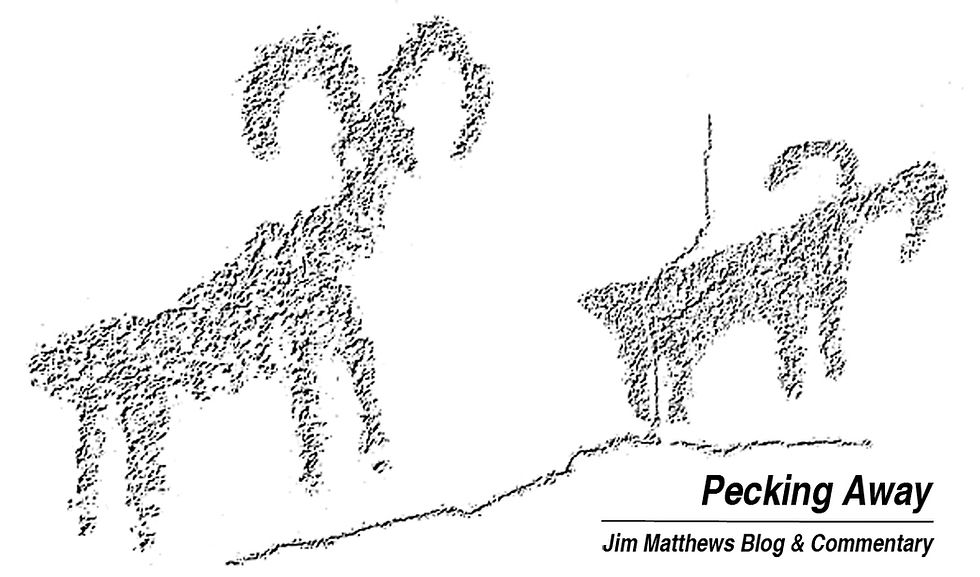San Jacinto Wildlife Area needs its full water allotment for expansion
- Jim Matthews
- Dec 26, 2015
- 4 min read

By JIM MATTHEWS
www.OutdoorNewsService.com
The duck hunting across Southern California’s public hunting areas has been excellent this year, but especially at the San Jacinto Wildlife Area in western Riverside County. So far this season, the San Jacinto Wildlife Area has had four shoot days where the average was better than three birds per hunter and four where the average was between one and two birds. All other shoot days have been between two and three birds per hunter.
This is simply unprecedented. Most years, San Jacinto shoots very well the opening day of the season and then the averages drop down to around one bird per hunter – or less – until this time of year when waves of migrants start pouring into the region and providing better hunting. But even then, the best daily shoot averages have been in the low 2s. While the average was down because of the bluebird day this past Wednesday at only 1.63 birds per hunter, the average was just over three on Dec. 19 and Dec. 16, and above two birds per hunter every other shoot day in December.
The wildlife area has also been running more hunters through the area per shoot day than in past seasons. This past Wednesday (Dec. 23), there were 150 hunters who sat in a blind at least some of the day. Opening day drew 238 hunters and there have been from 130 to 170 every shoot day since.
This is because the wildlife area has slowly been expanding its ponded areas and flooded uplands the past three years. This improved wintering habitat for ducks and shorebirds makes for a better wildlife area for all users – human and wildlife.
In 2016 it will be critical for all people who use the wildlife area to keep a close eye on the Department of Fish and Wildlife. The agency’s local management staff almost gave away the bulk of the wildlife area’s water supply this past year in what appeared to be very shady, if not illegal, deal. [You can read more about this story at this link: http://www.outdoornewsservice.com/#!San-Jacinto-Wildlife-Area-could-lose-its-water-supply-because-of-DFW-bungling/c18sh/553e8eb60cf23d01645806e2. It’s obvious the on-the-ground staff has been busting their humps to improve the ground for wildlife, and that is most evident in the waterfowl harvest numbers and the volume of hunters using the area.
If the DFW would demand that the 4,500 acre feet of water promised in the original agreement with the Eastern Municipal Water District remain the annual allotment, San Jacinto Wildlife Area could more than double the size of its wetlands in the future as funding and manpower allow. This past year, after a stir kicked up by local hunters and birders, the DFW extended the original agreement for another year with the water district instead of giving away the water.
Volunteers are needed for wildlife
water restoration projects in 2016
Cliff McDonald has set up the 2016 schedule for the Water for Wildlife volunteers who have been restoring and rebuilding both natural and man-made desert water sources for wildlife for 10 years in the eastern Mojave Desert.
While the National Park Service has denied McDonald and the volunteers from working in the Mojave Preserve again this year for specious reasons [story on this insanity here: http://www.outdoornewsservice.com/#!Mojave-Preserve-again-shuts-down-Water-for-Wildlife-guzzler-restoration-efforts/c18sh/565122c70cf26ffe7c212553], there will be four weekend work projects this spring on Bureau of Land Management lands in the east Mojave Desert north and south of the Preserve.
The volunteer weekends, are Feb. 19-21, March 18-20, April 8-10, and May 13-15. Most of the work this year will be on man-made guzzlers or desert water catchments that provide water for wildlife, often in areas where natural water sources have disappeared because of drought or nearby ground-water pumping.
Existing volunteers should have received an e-mail from McDonald of the project dates and tentative locations, but new volunteers are encouraged to contact McDonald by phone at 760-449-4820 or via e-mail at bigmc@citlink.net to get more information and get on the list.
Individuals who would like to help, but don’t have the time or physical ability can also make tax-deductable donations of money, supplies, or equipment to help do this important work. McDonald can also provide information on how to make donations and the supply “need” list.
Quail Forever Chapters in this region also need volunteers and/or donations to keep desert water intact for wildlife use.
In the western Mojave, the High Desert Chapter of Quail Forever is also setting its spring work schedule. This group will be working on guzzlers in the Shadow Mountains, Cajon Pass area of the San Bernardino National Forest, and other locations in the Barstow to Hesperia region this year. For more information, contact Neil Ringlee at nrringlee@yahoo.com.
In the Angeles National Forest and desert areas in the Palmdale-Lancaster region, the San Gabriel Valley Chapter of Quail Forever has been the main group doing water restoration on public lands. Like the other groups, it has monthly work projects from February into the summer. Robert Armijo is the club’s habitat coordinator and the contact for new volunteers. His number is 626-919-7663.
In the Red Mountain and southern Sierra region, the Ridgecrest Chapter of Quail Forever maintains over 70 guzzlers and is always in need of help. Contact Ron Page at 760-382-7602 or via e-mail at ch3176@pfofficers.org.
END























Comments